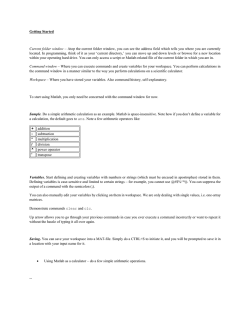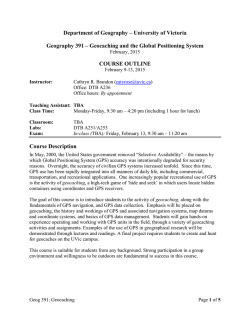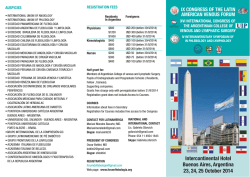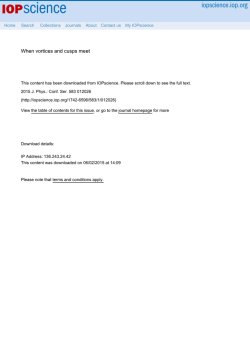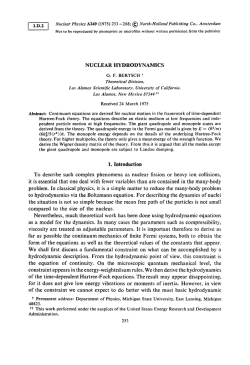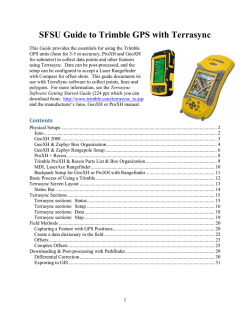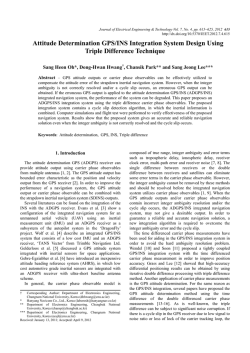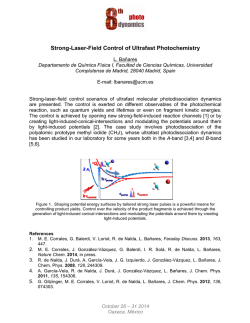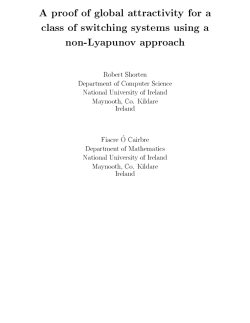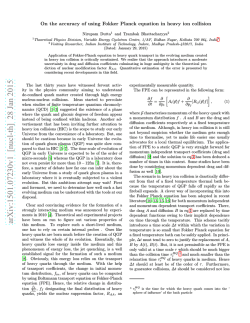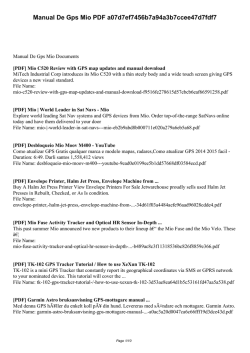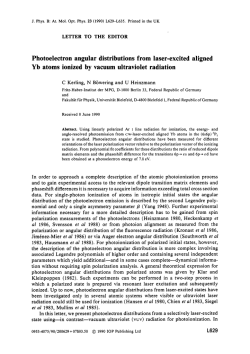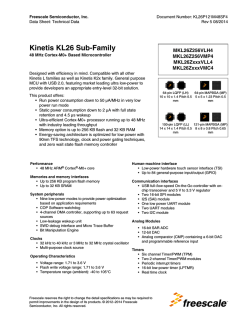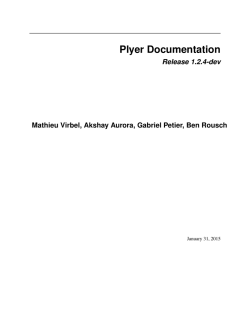
Gaussian pure states in quantum mechanics and the
Gaussian pure states in quantum mechanics and the symplectic group
R. Simon*
Centre for Theoretical Studies, Indian Institute of Science, Bangalore 560 012, India
E. C . G. Sudarshant
Center for Particle Theory, The University of Texas, Austin, Texas 78712
N. Mukunda
Centre for Theoretical Studies and Department of Physics, Indian Institute of Science, Bangalore 560 012, India
Gaussian pure states of systems with n degrees of freedom and their evolution under quadratic
Hamiltonians are studied. The Wigner-Moyal technique together with the symplectic group
Sp(2n,R)is shown to give a convenient framework for handling these problems. By mapping these
states to the set of n X n complex symmetric matrices with a positive-definite real part, it is shown
that their evolution under quadratic Hamiltonians is compactly described by a matrix generalization of the Mobius transformation; the connection between this result and the “obcd law” of Kogelnik in the context of laser beams is brought out. An equivalent Poisson-bracket description over a
special orbit in the Lie algebra of Sp(2n,R)is derived. Transformation properties of a special class
of partially coherent anisotropic Gaussian Schell-model optical fields under the action of Sp(4, R )
first-order systems are worked out as an example, and a generalization of the “abcd law” to the partially coherent case is derived. The relevance of these results to the problem of squeezing in multimode systems is noted.
I. INTRODUCTION
It is a well-known fact in both classical and quantum
mechanics that the dynamics of a system with a Hamiltonian quadratic in coordinates and momenta is closely
related to a real symplectic group. Thus for such a system with 2n phase-space variables, both the numerical
Hamilton and the operator Heisenberg equations of
motion are linear ordinary differential equations, whose
solution involves a one-parameter group of matrices belonging to the defining representation of the group
Sp( 2 n , W 1. This solution represents a canonical transformation in the classical case, and a unitary transformation
in quantum mechanics.
The simple dynamics of such systems leads, in quantum mechanics, to the study of a special class of wave
functions which maintain their general form as they
evolve in time in accordance with the Schrodinger equation. These wave functions are normalizable complex
Gaussians, which are therefore completely determined by
the means and variances of the coordinate and momentum operators. If one regards these means and variances
as time-dependent parameters characterizing the wave
function, then the Schrodinger equation for the latter
leads in a direct way to an in general nonlinear system of
evolution equations for the former. Such quantummechanical state functions have recently been given the
and for a particular
distinctive name “Gaussons;”
choice of quadratic Hamiltonian their evolution in time
has been studied in detail.2 Both ordinary and squeezed 3
coherent states are examples of “Gaussons.”
It is clear that a corresponding treatment of classical
’
systems of this type can be given at the level of the
Hamilton-Jacobi equation.
We are interested in this paper in quantum-mechanical
pure states with Gaussian wave functions [see Eq. (2.20)
below for a precise definition], and the evolution of these
states under the action of Hamiltonians quadratic in the
canonical variables. Such states have been called, in a
descriptive manner, “Gaussian pure states (GPS)”4 (or
“Gaussons”’).
The fundamental significance of the real symplectic
group Sp( 2 n , R ) in this context arises from the fact that it
is the group of linear automorphisms of the canonical
commutation relations among n pairs of coordinatemomentum operators. It follows that the Hilbert space
on which these operators act irreducibly carries a unitary
representation of Sp(2 n , W 1. The infinitesimal generators
for this representation are quadratic Hermitian expressions in the canonical variables, and these are possible
Hamiltonians for the class of systems under consideration.
While elements of S p ( 2 n , R ) act on vectors by their
representative unitary transformations, the action on
operators is by conjugation. It has been shown elsewhere’ that this action finds its most natural and direct
expression when operators are described by their
Wigner-Moyal representatives. It follows that this
description is suited also for a discussion of the behavior
of GPS’s under Sp(2 n , R 1, since one can set up the pure
state density operator for such a wave function and then
pass to its Wigner-Moyal representativee6
The purpose of this paper is to provide a complete
analysis of GPS’s along these lines.’ In particular the un-
itary action of the most general symplectic transformation on a GPS density matrix can be displayed explicitly.
We will see that Gausson states correspond one to one to
points on a special orbit in the Lie algebra s p ( 2 n , R ) of
Sp(2n,R) under the adjoint action. And the effect of an
element of S p ( 2 n , R )on a GPS is exactly representable as
a motion on this orbit. This motion in turn can be interpreted as a canonical transformation with respect to a
classical phase-space structure that intrinsically belongs
to the orbit. Thus the quantum-mechanical evolution of
GPS's according to the Schrodinger equation is exactly
equivalent to a classical canonical evolution of the parameters along this special orbit in sp(2n,R). This statement is true for any choice of Hamiltonian provided only
that it is quadratic.
The material of this paper is organized as follows. In
Sec. I1 we introduce the symplectic group Sp(2n,R) and
its action on canonical coordinate and momentum operators, and its associated unitary representation. The
Wigner-Moyal description of operators is then recalled,
and its special features with respect to Sp(2n,R)
displayed. With this preparation, the family of GPS's is
defined as a special subset of a more general family of
operators with Gaussian configuration-space kernels.
The problem of the unitary action of Sp(Zn,R) transformations on GPS's is posed. In Sec. I11 this problem is
converted, with the use of Wigner-Moyal representatives,
into a matrix-theoretical problem. It is shown that the
problem can be solved by exploiting the properties of the
very special orbit in the Lie algebra sp(2n,R) of
Sp(2n,R). The result is that any element of Sp(2n,Rj,
via its associated unitary transformation, maps each GPS
into another such state. The changes produced in the parameters of the state can be displayed in a rather elegant
form. Section IV sets up the classical phase-space structure on the Lie algebra sp(2n,R) orbit mentioned above,
and shows that quantum-mechanical evolution of a GPS
with a quadratic Hamiltonian operator is mirrored in a
classical canonical evolution of the parameters along this
orbit. A coordinate system for this orbit, which is both
global and canonical, is displayed. Section V describes an
application of the results of Secs. I11 and IV to a special
class of partially coherent optical fields, and Sec. VI contains some concluding remarks.
We consider a quantum-mechanical system based on
2n Hermitian coordinate and momentum operators
qr,hr,r
= 1,2, . . . ,n. It is convenient to set up a column
vector - with 2n Hermitian operator entries as
0
Q=(Q1,.
. . ,ghn,81,.. . ,a,)T .
(2.1)
Then the canonical commutation relations can be compactly written as
[
8, ,o,] =ifin,,
Qnxn
a , b = 1,2, . . . ,2n
L x n
Q, into Hermitian Q 1 according to
Q
=Sa,
Q,
(2.3)
will preserve the commutation relations (2.2) if and only
if the real 2n-dimensional matrix S =(So, ) obeys
sgs'=p
(2.4)
'
This is the defining representation of the group Sp(2 n , W 1.
We note that along with S, both S - ' and S T belong to
Sp(2n ,W).We shall ^be dealing with an irreducible representation of the Q,, which, for instance, in the
Schrodinger representation using eigenvectors of the Q
appears as
(4
; q rI t L ) = q , ( q
(4
18, I $ ) =
,$)=qrtL(q)
3
(2.5)
( q q')=6'"'(q-q')
~
.
The linear transformation (2.3) is then unitarily implementable, that is, there is a unitary operator U ( S ) for
each S E S p ( 2 n , R )such that
12.6)
An element of Sp(2n,R) close to the identity has the
form
j€l
S--Bf€J,
<<1.
(2.7)
The symplectic condition (2.4) then leads to
(BJ)T=PJ
.
(2.8)
Thus the infinitesimal generators of the defining representation of Sp(2n ,R)are in one-to-one correspondence with
real symmetric 2n x 2 n matrices: One passes from the
latter to the former by left multiplication by f-i . For an S
of the form (2.71, U ( S )has the expression
(2.9)
11. SYMPLECTIC GROUP, WIGNER-MOYAL
REPRESENTATIVES, AND GPS's
h
Eigenvalues of the q s and j3's will be denoted by q's and
K s , respectively. AAreal linear transformation taking the
i?? i
L.Lt
(2.2)
The basic properties of the Hermitian generators X ( J ) of
the unitary representation ?I(S1 of Sp(2n , R ) are
(2.10)
As J goes over the Lie algebra sp(2n,W) of Sp(2n,R),
X ( J goes over all Hermitian quadratic expressions in 6,
and P,.
We see from Eq. (2.6) that the action of Sp(2n,!R) on
the Q and jj is by conjugation. This equation is analogous
to the solution of the Heisenberg equations of motion in
quantum mechanics. In contrast, keeping in mind the
Schrodinger picture evolution of a density operator, we
define the action on such operators
f
by
f,=ucs,fu-'(s,.
(2.11)
It is natural to try to express this operator action in a
classical numerical form.* This is achieved by going to
the Wigner-Moyal representative of f,which is a function of 2n classical real v$ables q r , p , , r = 1,2, . . . ,n.
Similar to the definition of Q in Eq. (2.11, we define a numerical column vector Q as-
Q=(q1,
* .
., q n , p l , . .. , P n )T .
(2.12)
The Wigner-Moyal representative WCQ of the operator
f is defined as the partial Fourier transform of the
coordinate-space kernel l Y q ; q ' )of f:6
W(Q)=(2a)-"
I
dnq' r ( q - - q ' ; q + t q ' ) e x p ( i p T q ' ) ,
D ( Q, ) =exp(i@
- '@Q0
- )=exp(iplg - iglp
The properties with respect to
this discussion
(2.14)
In add$ion to the linear homogeneous transformations
(2.3) of Q, we also need to deal with translations in Q by
c-numbers. These are generated by the displacement
.
(2.15)
24s) relevant
u - ~ ( s ) D ( Q , ) ~ ( ~ ) = D ~ ~ .- ' Q , )
to
(2.16)
These relations correspond
to a unitary representation of
g
the semidirect product of Sp(2n, R with the group of
translations T2,,. Conjugation of a general f by D ( Q o )
alters r(q ; q ' ) and WCQ ) in the following ways:
= T ( q- q o ; q ' - q o
=W(Q-Qo).
Then we find5
0 and
D-~(Q,@D(Q,)=Q+Q, ,
f ' = D ( Q , )fD-'(Q,
(2.13)
f'=U(S)fU-'(S)- W ' ( Q ) = W ( s - ' Q ).
operators familiar from the theory of coherent state^.^
For any numerical Q, with entries qor,pOrwe define the
unitary displacement operator
)-
r'(q;q')
)exp[@T((q--fl')]==
W'CQ )
(2.17)
We shall be interested later in certain Hermitian operators f which have unit trace and whose kernels r(q;q')
are Gaussian. The most general f of this type can be
parametrized by three real n x n matrices L, M,and K,of
which the first two are symmetric
J
We have restricted the expression in the exponent to be
homogeneous quadratic in q and q ' . We further require
both L and L+M to be positive definite, ensuring, respectively, that the trace is finite and that the integral
occurring in Eq. (2.13) can be carried out. The normalization constants in the definition (2.18) have in fact been
chosen to ensure unit trace. The Wigner-Moyal representative of f , , , , is
WL,M,K
( Q ) =a-n[detk /det(L_ +M )]'/2exp(-Q TGQ
-) ,
G=
I"
C T
B ,
A =2L_+iK T(L_+M)-'K ,
(2.19)
B =gL_+MI-' ,
C=+&
T(L+M)-' .
We see that it is completely characterized by a real symmetric (positive-definite) 2n x 2n matrix p formed out of
L, M , and K.
With these preliminaries and notations established, we
can define a general GPS. It is parametrized by a column
vector Q o , and two real symmetric n xn matrices _U,_Vof
which Ge former is positive definite. We combine Y and
Y into a complex symmetric matrix Z=_V-iY, and
denote the GPS by I $z,Qo). Its wave function is
This wave function is normalized to unity, and what appears in the exponent is the most general at most quadratic complex expression in q. It is normalizability that requires that g be positive definite.
From the point of view of classical beam optics, it is
useful to note that Eq. (2.20) is a multidimensional generalization of coherent Gaussian (laser) beams. We are
speaking here of coherent beams as opposed to partially
coherent beams in classical optics, and this should not be
confused with the quantum-mechanical coherent states
wherein
would be the identity matrix and _V the null
matrix. In the beam case with the beam assumed to be
propagating in the x 3 direction, q = ( x I , x 2 ) is a twodimensional vector in the transverse plane with +(q ) and
1 $'(q 1 1 giving, respectively, the complex field amplitude
distribution and the intensity distribution in that plane.
If we consider Gaussian beams with general astigmatism,
then _U and _V are real symmetrix 2 X 2 matrices wirh _V
positive definite to ensure finiteness of the integrated intensity (normalizability) over the transverse plane. In the
isotropic or rotationally invariant case (absence of astig-
'
matism) _V is any positive constant times the unit matrix
and _V an arbitrary real constant times the unit matrix.
In either case the paraxial propagation equation of ciassical wave optics gives the evolution of the beam from one
transverse plane to another transverse plane. It turns out
that the Gaussian form of $44) is preserved under this
paraxial propagation, and hence the effect of propagation
about the x 3 axis is simply to make the 2 x 2 matrices _V
and _V evolve as functions of x 3 . l o
Our aim now is to show that these states (2.20) transform in a simple way amongst themselves under action by
24s) for any SESp(2n,W). To this end we first calculate the kernel of the pure-state density operator
determined by 1 $z,Qo). After some simple algebraic
manipulations, it is shown that this kernel is expressible
for special choices of parameters
in terms of rL,M,K(q;q')
and arguments
pZ,Qo=
I $Z,Q,
)($Z,Qo
1
PZ,Qo(4 ; 4 ' ) =
U / 2 , 0 , - V (4
The change of Q , to Qb is completely independent of
Wo(Q ) and its changes. In dealing with GPS's we can
therefore restrict ourselves to 13,) and study their
Sp(2n1R 1 transformation properties.
The key point now is to see that for any S E Sp(2n, W 1,
U ( S ) maps 1 qZ } into 1 q Z . )for a suitable Z ' , and to
display the transformation law taking Z to Z ' . Of
course, one must make sure that 2' is a member of the
same family of matrices to which Z belongs. For these
purposes it is most convenient to work with the WignerMoyal representative of Pz, which is, using Eqs. (2.19)
nn,,
0,xn
_v
n,,,
I
9
(2.27)
(2.21)
- qO;q'-qO
x e x P [ q orC9-g')l
.
Comparing this with Eq. (2.17) it is clear that the Qo
dependence separates completely from the 2 dependence
According to Eq. (2.14), if ? 4 S ) maps PZ to P ' , the
Wigner-Moyal representative W'(Q ) of 8' is obtained
from W , ( Q ) by a linear transformation on the arguments:
(2.22)
At the state-vector level this separation brings in an extra
phase factor
(2.23)
qZ( q 1=~ - " / ~ ( d e t _)1/4exp[
U
- +Q '(_V +i_V)q
-] .
This separation of Z and Qo is maintained under action
by 24s)for any S E Sp(2n, R 1. In fact, on account of Eq.
(2.16)we can see quite generally that if two operators f,
and f are related by a displacement operator D ( Qo ),
P=D(Q,
)f@ - ? Q , ) ,
(One may be tempted 5 to avoid the excessive appearance
of S - ' in the above expressions and hereafter, by altering
the conventions so far adopted. However, we choose not
to do so, in order to be consistent with established usage
in optics especially in relation to the "abcd law" which
we generalize in Sec. V.) Our task is to show that there
are real symmetric n ~n matrices
and _V', the former
being positive definite, such that
a'
G'=G(_U',_V') ,
(2.24)
then their transforms by U ( S) are similarly related:
fb=U(S)f,U-'(S) ,
f '="U(S ) f U - ' ( S ) = D ( Q b ) f p-l(Qb ) ,
(2.25)
Qb=SQo
(2.29)
and to exhibit _U' and _V' in terms of 2, _V, and y. We
take up these questions in Sec. 111.
To conclude this section we return briefly to the complete GPS I $ z , Q , > By
. Eqs. (2.17),(2.221, and (2.27),the
Wigner-Moyal representative of the density operator
h,Q0
is
In terms of Wigner-Moyal representatives this means
that if W , and W , corresponding to f, and
respectively, are related by an initial phase-space displacement Q o ,
then S E Sp(2n, R maps them into Wb and W' which are
related by a transformed displacement Qb:
b,
(2.26)
=.rr-"exp[-(e-eo)%(_V,_V)(Q-_eo)]
-
.
(2.30)
Therefore using the Weyl rule for associating a :-number
function of Q with each operator function of Q, we get
the following values for the means and variances of the
and ps in a general GPS:
rs
s T.l
From the identification (3.1) in terms of Lie-algebra
elements, we see that as S ranges all over Sp(2n,R) the
passage from G(Q,_V)to G' given in Eq. (2.28) corresponds to conjugation of J ( _ V , _ V ) and so to passing from
J ( Q , _ V ) to all other elements J' on the orbit of J ( _ V , _ V )
defined by the adjoint action
G'=(S-')*G(_U,_V)S
-' ,
J'=pG'-J'=sJ(_v,_V)S
-
that is,
=iiPab
++[G(U-',-_V)]ab *
Naturally, these means and variances determine pz,e,
completely.
We conclude this section with the following observations. GPS's in the context of systems with one and two
degrees of freedom have been studied in great detail in
Ref. 4. But our analysis in the present paper is for a system with an arbitrary number of degrees of freedom, n.
Thus, our results in this preparatory section when specialized to n = 1,2 should be expected to give results consistent with the results of Ref. 4. In particular, compare
our Eq. (2.20) and Eq. (2.311, respectively, with Eq. (3.2.1)
and Eq. (3.3.19b) of Ref. 4. It should be added, however,
that the principal results of this paper are the matrix generalized "abcd law" [Eq. (3.27) below] and the quantum
description through classical Hamiltonian dynamics on a
special orbit in the Lie algebra sp(2n, R 1 of Sp(2n, R )
presented in Sec. IV, both of which are new and go well
beyond the results in Ref. 4 even for n = 1,2.
111. ACTION OF SYMPLECTIC
TRANSFORMATIONS ON GPS's
Each GPS density operator (with Q, =O which is hereafter assumed) has been seen to be uniquely characterized
by a real symmetric positive-definite 2n X 2 n matrix
E(_V,V).We examine the properties of the family of matrices arising in this way. On account of the symmetry,
Eq. (2.8) shows that each such matrix is uniquely associated with an sp(2n,R) matrix J ( _ U , _ V ) :
I (_v, _V 1 =BG
- (Y,_V ) E sp( 2 n , R 1
.
(3.1)
Thus we have a property at the Lie-algebra level. What
is perhaps surprising and somewhat unusual is that the
matrices G ( Q , y )are also elements of Sp(2n,R),i.e., they
belong to the defining representation of this group. This
can be seen directly by checking that, since _V and _V are
symmetric, Eq. (2.4) is satisfied by G(_U,_V).A more useful way of expressing this property is to write
(3.3)
-' .
At the same time Eq. (3.2) shows that G(_U,_V)is the
symmetric transform (or better symplectic transform), via
S(_U,_V),of the unit matrix
G (_U, _v ) = [S - I ( _U, _v ) ] 'G
G 'O'=S(Bn
'0's- '(
X n ,On X n ) = 1 2 n X2n
Y, _V ,
(3.4)
*
Equivalently, J ( Q , _ V ) arises from J'o'=J(P,xn,Onxn )
= p by adjoint action with S(_V,_V).Let 0 be the orbit of
B:i s p ( 2 n , ~ ) ,
O = { S-P S - ' ~ S E S p ( 2 n , R ) J.
(3.5)
Then each J ( _ U , _ V ) belongs to 0 , and so does J ' obtained
from J(_U,_V) by Eq. (3.3). What must be shown, in order
to clinch the issue, is that each point on 0 is uniquely
characterized by a pair of real symmetric n X n matrices
(_U,_V) with _U positive definite; or in other words, that
such (_V,_V) give a global coordinate system for 0. If this
is so, then Eq. (2.29) and the corresponding J equation
would follow
13.6)
Before doing this, however, we note two interesting
consequences of the already established Eq. (3.4). The
first is that we have here an explicit and simple instance
of a fundamental theorem of Williamson'' which states
that any real symmetric positive-definite 2n x 2n matrix
G can be brought to diagonal form, with positive diagonal entries, by a symmetric transformation with a symplectic matrix S E Sp(2n, R 1. The diagonal matrix concerned is called the normal form of G. In this sense, the
normal form of each G(_U,_V)
is the unit matrix. Incidentally this means that any two such matrices, G(_U,_V)
and
G(Q',_V'1 are related by a suitable symplectic transformation. The second point is that any GPS I qZ ) can be unitarily related via U S ) for a suitable S E Sp(2n, R)to the
>,
_U'Oi=lnxn
and _ V ' O '
standard GPS 1 ~ z c o l where
-0, X n , up to a phase factor,
(3.7)
G(_U,_V)=[ S -'c_U,_V,]*s
-'(_U,_V)E
Sp(2n , R ) ,
We now prove our main result concerning the possibilit y of using (_U,_V) as a global coordinate system for 0.
(3.2)
[Here we recall that if
S belongs to Sp(2n,W), so does
We want to show that for any J E O , G = -@J is G(_V,_V)
for a unique pair (_V,_V). Starting with the Williamson
normal form G ( 0 ) = & 2 n X Z n , we consider the family of _G
matrices
a = ( @- ' Y S
J S E S p ( 2 n , R ) j.
-I
(3.8)
This set of matrices is just -p times the set of generator
matrices 6: We have passed Eom the J to the G description. Every G E 6 has the following three properties:
G is real symmetric ,
p
is positive definite
(3.9a)
,
(3.9b)
GESp(2n,R).
(3.9c)
A C
(3.12~)
T = u .
Keeping in view the form of G(_U,_V)in Eq. (2.271, we
write
B=_U
_C=m ,
-I,
(3.13)
--I
thereby defining uniquely a real symmetric positive
definite _U and a real _V. Then Eqs. (3.12) are, in the same
sequence,
Conversely one can easily check using Williamson's
theorem that any _G having these properties belongs t o d.
So we have
8 = { G I G obeys Eqs. (3.911
.
(3.10)
In this form we can easily show that any G E 6 is
G(_U,_V)
as given in Eq. (2.271, for a unique pair (_V,_V).
Properties (3.9a) and (3.9b) imply that if _G is written as in
Eq. (2.19) with n X n real submatrices A, B, and _C, then
A and @ are symmetric positive definite:
(The positive definiteness of G implies more than this.)
We now impose the symplectic condition (2.4) on G to get
three independent matrix relations:
CTB=BC,
AB=Bnxn+G'
(3.12a)
2
(3.12b)
3
We get from Eq. (3.14a) the symmetry of 1;then (3.14b)
gives A explicitly in terms of the pair CQ,_V) while ( 3 . 1 4 ~ )
is identically satisfied. Thus the G of Eq. (3.11) has been
shown to be G(_U,_V)for the unique pair C_U,_V) identified
by Eq. (3.13). At the same time, the positive definiteness
of G(_U,_V)
is obvious from its factored form-in Eq. (2.27).
It is thus established that each G E O ( L E O ) is
G(_V,_V)[ J ( _ V , _ V ) ] for a unique Cy,_Vand
) vice versa;
therefore Eqs. (3.6) do hold with (_U',_V') being determined as functions of (_U,_V) and
We conclude this
section by developing an explicit solution for (_U',_V' 1.
We use the factorization of G(_U,_V)in terms of
SC_V,_V)given in Eq. (3.2) [similarly for G ( _ V ' , / ' ) ]and
exploit the symplectic property (2.4) of these matrices
and of S, to express Eq. (3.6) in this way:
s.
(3.15)
so Eq. (3.171 is
This motivates the definition
=+=at.
(3.19)
Now
(3.16)
where z=_V-i_V
as before. Therefore Eq. (3.13, which
must yield Z ' in terms of Z and S , is
[(_U',_V')g- +(_U),_V) ) = ( S - 1
Fg_V,_V)gt(_U,/)S- I .
(3.17)
The strategy is to extract [(_U',_V') in terms of f(_U,_V)
and S. For ease in the ensurng manipulations, let us write
the 2n x n matrices
x=cs
,
-1)7f(y,_V)
-
Y +_y=g
- f(_U#,_Vf)g(_Uf,_v?
=( _U' 1- 1 '2[nn
+ ( z )+Z](_U' 1- 1'2
is evidently Hermitian, positive definite, and nonsingular.
From Eq. (3.19) we get
t
t(Xt 11,
(1
1 I 2 = ( X t1)
proving that
(3.19)
X $1
is nonsingular.
(3.21)
We also get from Eq.
YY t_y=xxt Y ,
and
Y=[(_U',Z')
,
(3.18)
(3.20)
which allows us to "solve" for 1in terms of X :
(3.22)
(3.23)
Let the Hamiltonian operator fi be determined by a
real symmetric 2n X2n matrix h, and let us use Eq. (2.9)
to write it as one of the generators of U ( S 1,
The important property of the n X n matrix _W is that it is
unitary, as shown by Eq. (3.21):
(4.1)
(3.24)
If we write the symplectic matrix
block form as
S and its inverse in
The unitary time-evolution operator for a finite time t is
-,&-e
-ltX(JgJ
=U(S(t))
,
(4.2)
rJ
S(t)=e '~Sp(2n,iR).
(3.25)
then Eq. (3.23)gives the n X n matrix equations
z'(_u')-'/2=(&-c)_V
- l/2w
-
(_u')-''2=((z-f?Z)u-'/*_W
,
.
(3.26)
The existence of an inverse to ((z-u)
is assured since
we know that _V,
and _W are all nonsingular. Therefore, even though _W containing the "unknown" _U appears on the right-hand sides of these two equations, we
can combine them to give us the solution for z' in terms
of and S that we are looking for,
u',
z
Z'=(&-c)(g L
g) - I .
(3.27)
This is the transformation law for Z under S p ( 2 n , R )
promised earlier. _V' and _V' can be obtained by separating
into its imaginary and real parts, remembering
that (z, b, and d are all real. Thus Eq. (3.27) expresses
the (nonlinear) adjoint action of Sp(2n, R)on the orbit 0
(equally well d 1, telling us how an element S E Sp(2n,R)
maps a point CY,_V)on 0 to
For future reference, we rewrite Eq. (3.27) in terms of A r
(the
is nonsingupositive definiteness of _U guarantees that
lar):
Here we used the general connection
c(y(e'J)=e
-1dfJi
(4.3)
implied by Eqs. (2.7) and (2.9). Therefore if at time t =O
we have a G P S 1 $z(oJ) which evolves to I $ Z c t , ) at time
t,
=U(S(t )) j
$Z(O,)
,
(4.4)
then the matrix G(O)for the initial Wigner-Moyal distribution evolves to G ( t ) by
G ( t ) = [ s- Y r )]'GCOS- ' ( t ) .
(4.5)
This is obviously the solution to the linear differential
equation
z'
(u',_V').
-z-'
z
A ' = ( g A + b )(cA+d 1 - l
.
(3.27')
Going back to the GPS's (with Q,=O), we can complete Eqs. (2.28) to the statements
(3.28)
which establishes and shows exactly how each such state
is taken into another such state by any element of
Sp(2n, R ). Reinstating the displacement Q , in the GPS's
is a trivial matter because of the semidirect product
structure noted earlier, and need not be spelled out in detail.
IV. SCHRODINGER EQUATION FOR GPS'S
AS AN EQUIVALENT CLASSICAL SYSTEM
We have seen how a G P S j $z ) changes under action
by 24s)into another G P S 1 $z,), with S being any element of Sp(2n, R 1. We now specialize to the solution of
the Schrodinger equation for a given quadratic Hamiltonian.
=@do@- ' G ( t ) - G ( t )Lo
(4.6)
with prescribed initial conditions. In fact, of course,
G ( t )isdetermined byZ(t)=_V(r)-ii_U(t)as
G ( t )=G(_U(t),_V(t) )
(4.7)
in the notation of Eq. (2.27); and the primitive evolution
equations, of which (4.6) must be viewed as a consequence, are nonlinear ordinary differential equations for
U ( r ) , _V(t). The essential point is that the quantummechanical Schrodinger equation for the G P S I ~ z , ,) i
reduces to these evolution equations for Z ( t or G ( t 1. It
now turns out that these latter equations can be put into
a classical canonical form in an intrinsic and natural way,
on account of the geometrical properties of the orbit
O C s p ( 2 n , R ) . We show this by first exposing the nature
of 0 as a coset space, and then appealing to general
theorems which allow the setting up of a classical phasespace structure on 0.
From the definition of 0 in Eq. (3.3, it is clear that the
action of Sp(2n,W) on 0 is transitive. This means that 0
is essentially the coset space Sp(2n ,R)/H,
where H is the
subgroup of Sp(2n, R ) which leaves the representative
point J'''=f? on 0 fixed. Since the dimensions of
S p ( 2 n , R ) and 0 are n ( 2 n + 1 ) and n ( n + l ) , respectively
[the latter follows from the fact that (_V,_V) is a coordinate system for 01, H must be an n2-dimensional subgroup. The elements S in H must obey the two conditions
srps=p,
s-’ps=p,
which means S T=S
(4.8)
-’ or S E S O ( 2 n ).
Therefore H is
the intersection
H=Sp(2n,R)flSO(2n) .
sp( 2n, W ) in a convenient way. In the defining representation, a basis xab for sp(2n,!R) is obtained by taking a
basis Yab for real symmetric 2n X2n matrices, and multiplying them on the left by 0. [This is the convention used
in Eqs. (3, l ) , (3.3), and (4.fl.] We make the choice
(4.9)
By examining the infinitesimal generators of H , we shall
show that H = U ( n ). For J E Y f , the Lie algebra of H,
the two conditions (4.8) lead to
(4.10)
(4.15)
so that a general real symmetric 2n
has the expansion
G =+Gab Yab
x 2n matrix G =(Gab )
.
(4.16)
A basis for sp(2n, R is then
n
whose block
Every J € % is thus a real 2n ~ 2 matrix
form is
(4.17)
(xab )cd =Pca6bd
(4.11)
Here A and p are real n xn matrices. The infinitesimal
transformation (2.7) acting on a column vector Q produces the changes
The commutation relations among the xab are calculated
to be
[Xab,Xcd l = P a c X b d
+BudXcb
+PbdXca
(4*18)
*
ab
Xah
(4.19)
(4.12)
.
to accompany (4.16), so the symmetric coefficients Gab
These real equations are identical to the single complex
matrix transformation equation
q ’ + @ ‘ d B n x n+ E ( h + i @ I ( g + @ )
.
(4.13)
Since &+iy is the most general anti-Hermitian n ~n matrix, we have here a general infinitesimal transformation
of the unitary group U(n 1. This establishes that
H=Sp(2n,R)nSO(2n )=U(n)
O=Sp(2n,R)/U(n 1
+PbcXad
These are the basic Lie bracket relations for sp(2n,R).
The generator matrix J =pG
- has the expansion
J=$G
p ’ s p + d h p +yq 1
.
+Pcb60d
.
,
(4.14)
We now want to give the evolution equations (4.6) a
classical canonical meaning. These equations describe a
particular one-parameter group of motions along the orbit 0. According to a general theorem due to Kostant,
Kirillov, and Souriau,’’ for any Lie group G the coset
spaces G / H which permit the definition of a G-invariant
symplectic structure are either orbits in the coadjoint
representation of G acting on 9* (the dual to the Lie algebra 9 of GI, or covering spaces of such orbits. For a
semisimple G, such as Sp(2n , R ) , we can deal with orbits
in 9 rather than in 9*;and every orbit in 9 does carry a
G-invariant symplectic structure. This is in particular
true for G=Sp(2n,W) and the orbit O C s p ( 2 n , R ) . In
principle the symplectic structure can be defined directly
and intrinsically on 0. However, both for calculational
ease and physical understanding it is better to define a
singular system of generalized Poisson brackets on the
full Lie algebra sp(2n,R), and then restrict them to the
orbit 0. The Sp(2n ,R)invariance (better, covariance) of
the procedure will be obvious throughout.
We need to set up the commutation relations for
are to be treated as the independent components of
J € sp(2n, R 1. That is, the n ( 2n 1 ) independent real
variables Gab= Gb, are (linear) coordinates for sp(2n, R 1.
Among them we define a system of singular generalized
Poisson brackets patterned after Eq. (4.18),
+
I Gab, Gcd 1 =Bat Gbd + p b c
Gad + P a d Gcb +Phd Gca
‘
(4.20)
These are manifestly covariant under the action of
Sp(2n, R on Gab,which is given by
Gab -+ Gdb = ( 8
~
’ Ica (8 ’
-
)db Gc,
.
(4.21)
The Poisson bracket between any two functions f ( G 1,
g ( G ) is calculated from the basic brackets (4.20) by using
the derivation property.
At this stage, one can easily see that the (linear) evolution equations (4.6) can be put into the classical canonical
form, in the sense of the Poisson bracket (4.20), with the
use of a Hamiltonian function linear in the G’s,
(4.22)
However, as already remarked, the primitive evolution
equations, corresponding to the quantum-mechanical
equation of motion for a GPS, are not really Eq. (4.6) but
the nonlinear evolution equations for U ( t ) and V ( t) implied by Eq. (4.6). This aspect is closely related to the
question of restricting the Poisson bracket (4.20) to (the
orbit) 0, a procedure which can be consistently carried
out because (4.20) is S p ( 2 n , R ) covariant. Namely, if
C3 G ) is any (polynomial) Casimir invariant of sp(2n, It3 1,
the singularity of the brackets (4.20) shows up in the fact
that
[G,,,(?(G)]=O
(4.23)
identically. Therefore we are permitted to assign each
@ ( G ) some numerical value, without in any way
conflicting with the Poisson-bracket definition (4.20).
The independent
G 1 are the traces of even powers of
EG, and the restriction of G to d is achieved by specifying
e(
T r [ (-P G ) 2 ' ] = ( - 1 ) ' ~ 2 n , 1=1,2,.
..,n .
(4.24)
Once we know that G E 6 , we can use the variables
(_V,_Vi as independent coordinates on d; the brackets
(4.20) then imply definite values for the brackets among
the elements of LL and _V. In this way we find that (4.20)
leads to the canonical Poisson brackets2
Thus the r s and _V -"s can be thought of as q's and p's
intrinsically and globally defined on 6 (or 0 ) . And the
primitive equations of motion for U ( t and V ( t1, describing the unitary time development of GPS's under the
Hamiltonian operator & of Eq. (4.1), are
--
dy
dt
- ILL, -ypbp),&"_V)I,,
1
1
Qnxn
Qnxn]
Pnxn
,
-l)Ta
.
(5.1)
Let us now consider all those AGSM fields whose L_,
The nonlinear nature of these equations is evident when
one sees how G(_U,_V)is built up from (_V,_V) in Eq.
(2.27). However, the solution is already known to us [a
particular case of Eq. (3.27)], and is a canonical transformation on 6. We conclude this section by noting that
the particular Hamiltonian studied by Birula' corresponds to
h=
G'=(S
M,and & are such that the Williamson normal form of G
t
(4.26)
-
w has for brevity been omitted.) It is characterized by the
three real 2 X 2 matrices L,M , and &. Apart from the requirements that L and L_+M be positive definite, there
are two additional conditions (involving L.,M, and the antisymmetric part of K ) 5 which must be satisfied if f ' L , M , K
is to be a positive-semidefinite operator, which is necessary for r L , M , K ( q
to; be
q')
an acceptable optical twopoint function.
First-order optical systems (FOS's),'' of which free
paraxial propagation is an example, act in an especially
simple way on paraxial fields. Each such system can be
represented as an element S of Sp(4,R). Elsewhere we
have shown that every S ESp(4,R),including inverse free
propagation, can be synthesized using thin lenses." Its
action on the so-called Wolf function2' W (Q ) [related to
the optical two-point function r(q;q')
by Eq. (2.1311 is
given by Eq. (2.14). It follows that if we have an AGSM
field rL,M,K(q;q'),
its Wolf function is Gaussian and is
characterized by a 4 x 4 matrix 4. built up from L , M , K
as in Eq. (2.19); and when this field passes through an
FOS corresponding to S E Sp(4, R ), we get an altered
AGSM field whose matrix G' is
is a multiple of the 4 x 4 unit matrix
G ( " = K L ~ ~O , < K < ~ .
The limits on K arise from the extra conditions mentioned
above that ensure that pL,M,Kis positive semidefinite.
Then G must be of the form
G =K(S -')'s- I ,
and in that case Eq. (4.26) above gives his Eq. (2.19).
V. APPLICATION TO GAUSSIAN SCHELL-MODEL
FIELDS IN OPTICS
The results on the action of Sp(2n, R ) on GPS's find an
interesting application, in the case n = 2, to a special class
of partially coherent optical fields contained among the
so-called anisotropic Gaussian Schell-model (AGSM)
fields. l 3 Both isotropic Gaussian Schell-model fields'43l 5
and AGSM fieldsi6have played a key role in recent studies in radiometry of partially coherent sources. Like other paraxial optical fields, the two-point correlation function" of such a field can be specified on a twodimensional plane transverse to the beam axis, and it
then evolves along the axis. A general AGSM field has a
two-point function (cross-spectral density) rL,M,K
( q ; q ')
of the form given in Eq. (2.18), except for an overall real
multiplicative constant. (A dependence on the frequency
SESp(4,R) .
(5.3)
It follows that each such 4: is K times some element of the
set of matrices d defined in Eqs. (3.8) and (3.10) (for
n =2), so there must be a unique pair (_V,_Vi such that
G=KG(_U,_V).
(4.27)
(5.2)
(5.4)
This collection of matrices can be denoted 6,: The previous 6 is 6, and corresponds, in the present optical context, to coherent anisotropic Gaussian beams.21 Then,
forms a global coordinate system for
for each K , (y,_V)
6,; and 6, is a realization of the coset space
Sp(4,R)/U(2). We can invert Eqs. (2.19) to get ,L, M ,
and & for an AGSM field whose G matrix is KG(a,_V 1,
L
&=--_V.
As a subset of the set of all AGSM fields, what we have
here is what was called Type I in Ref. 13. An Sp(4,W)invariant characterization of the G matrices of such fields
is
(5.6)
We see from Eqs. (3.6) and (5.4) that under action by the
FOS S ESp(4,R), the G matrix changes thus:
-‘=KG(_U‘,_V’)
. (5.7)
G=KG(Y,_V)-+G’=(S
The rule for calculating (_U‘,_V’) from (_V,_V) and S is the
same as with GPS’s, i.e., the “abcd law” remains valid,
K’=K,
z’ =_v’- i_V‘= (a
-c )(a-&
,
(5.8)
1
L?’=(ah+b) ( c h + d1- ,
where a, b, G and are 2 x 2 blocks making up S. We
also see from Eq. (5.8) that the matrix &, determining the
phase of the two-point function, is symmetric for Type I
AGSM fields, and this symmetry is preserved upon action
by any FOS. It should however be noted that K _ is not required to be symmetric for a general AGSM
While this application of the geometrical results of
Secs. I11 and IV to optics involves n =2, we can easily see
that G matrices of the form KS(_V,_V~
for general n are
what occur in the Wigner-Moyal descriptions of the
thermal states of an n-dimensional isotropic oscillator,
and all Sp(2n, R ) transforms of such states.
VI. CONCLUDING REMARKS
We have presented a complete analysis of the action of
symplectic transformations on Gaussian pure states in
quantum mechanics. By connecting up this problem to
properties of and motions on a special orbit in the Lie
algebra of Sp(2n,R), it has been possible to present this
action in an elegant geometrical form and also in a classical phase-space framework. It is worth remarking that
induced by S E S p ( 2 n , R )
the mapping (_V,_V)-+(_U’,_V’),
and given by Eq. (3.271, is, for any S , a canonical transformation with respect to the Poisson brackets (4.20)
which, on 6,have the usual canonical form (4.25). In
this context we may point out the special significance of
this “abcd law” which has been established here in matrix form. The original “abcd law” due to Kogelnik” referred to the action of axially symmetric first-order optical systems, which correspond to elements of SL(2, R 1, on
axially symmetric coherent Gaussian beams L e n , to the
n = 1, K = 1 case).
For a coherent Gaussian beam of wave number k propagating along the z direction, the field distribution in any
transverse plane is of the form
3 ( x ,y ;q ) = ( 2/77 )”’a-’exp[ ik ( x* f y * )/2q ] ,
q - ‘ = R -‘+2i/ka
plex radius of curvature changes in the following simple
way:
.
(6.1)
Clearly R is the radius of curvature (of the phase front)
and a is the spot size (beam width) in that plane. The parameter q is known as the complex radius of curvature.’0’22Kogelnik’s original “abcd law” showed that under the action of a FOS
(6.2)
the Gaussian nature itself is preserved and only the com-
(6.3)
We have elsewhere generalized this to cover the action
of such optical systems on partially coherent Gaussian
Schell-model fields of both isotropicI5 and anisotropic13
types. The results (3.27) and (3.27‘) can be viewed as a
grand generalization of the “abcd law” (6.3) to n dimensions and in matrix form. [In fact, we have a further generalization to mixed states (for any n in Eq. (5.81, since
6, corresponds to pure states if and only if K = 1. ] A
particular case of this, corresponding to solving the
Schrodinger equation for GPS’s with a specific Hamiltonian operator, has been presented earlier by Birula.*
For his Hamiltonian,
I- 1
b(t)
S(t)= c(t) d(t)
g(t)
c o s ( ~ t ) -Q - ‘ s i n ( ~ t )
cos(Qt
= jQsin( Rt )
1
(6.4)
5
and by noting that Q is symmetric and that his i& is the
negative of our z=_V-i_V,
it is readily seen that our
“abcd law” (3.27) indeed gives his Eq. (2.27).
For n =2, the matrix “abcd law” applies to the action
of a general anisotropic FOS on an AGSM field. It is
quite remarkable that the “abcd law” holds for any
S E Sp(2n,R ) .
From the mathematical point of view, the law (3.27) is
quite significant. It is well known that the group SL(2, R
acts as a group of point transformations-the Mobius
transformations-on a complex half-plane, for instance
the lower half-plane. This action is closely connected
with the existence of the discrete series of unitary irreducible representations of SL(2, R ). 23 In contrast, the
group SL(2,Q:)neither possesses such an action nor such
unitary
representations.
Since SL(2,R)=Sp(2,R)
=SU(1,1), it is a priori not clear in which direction a
generalization might exist. Our result gives a matrix generalization of the Mobius transformations for the symplectic group Sp(2n,R). The lower half of the complex
plane for one complex variable is replaced here by the
family of complex symmetric matrices =_V- i_V with _V
being positive definite. And the easiest way to see that z’
obtained from z by Eq. (3.27) is of the same nature seems
to be via our analysis of the special orbit 0 in sp(2n,R)
given in Sec. IV. Further implications of the existence of
such an action will be studied elsewhere.
- ’ , - - y )is the
Finally we note that G - ‘ ( u , y ) e G ( g
matrix of second moments (fluctuations) in the canonical
variables, as can be seen from Eq. (2.31), and from Eq.
(2.28) it follows that the evolution of these fluctuations
under the action of any quadratic Hamiltonian is
governed by
z
G - ‘ ( g ( ),_V(t
l
))=s‘ ( t )G -‘(u(O),y(O))$(t)
.
(6.5)
i n fact, this evolution equation is valid for the second
moments in any state, provided that 4. -‘(&!,y)is replaced by the matrix of second moments in that state.
Since it is the dynamics of these fluctuations which is of
concern in the study of squeezed states, it follows that
our results are of relevance to squeezing in multimode
systems.24
As noted earlier, GPS’s for n = 1,2 and in particular
squeezed coherent states for single-mode and two-mode
systems have been studied from a different point of view
in Ref. 4. W e further note that the squeeze operators are
a subset of the elements we have studied. Since our
“abcd law” in Eq. (3.27) and the equivalent formulation
in Sec. IV of the quantum evolution of GPS’s as classical
Hamiltonian evolution on the special orbit in the Lie
algebra of Sp(2n ,W)as phase space are valid for arbitrary
n, it will be desirable to have a detailed analysis of
squeezing and the evolution of squeezed states in n-mode
systems from the point of view of these formalisms; we
shall return to it elsewhere.
‘Permanent address: Institute of Mathematical Sciences, Madras 600 113, Tamilnadu, India.
tAlso at Centre for Theoretical Studies, Indian Institute of Science, Bangalore 560012, India and at Institute of Mathematical Sciences, Madras 600 113, Tamilnadu, India.
‘I. Bialynicki-Birula and J. Mycielski, Ann. Phys. (N.Y.) 100,
62 (1976);Phys. Scr. 20, 539 (1979).
21. Bialynicki-Birula, in Coherence, Cooperation and Fluctuations, edited by F. Haake, L. M. Narducci, and D. F. Walls
(Cambridge University Press, London, 1986).
3D. Stoler, Phys. Rev. D 1, 3217 (1970);H. P. Yuen, Phys. Rev.
A 13, 2226 (1976);J. N. Hollenhorst, Phys. Rev. D 19, 1669
(1979);D. F. Walls, Nature 306, 141 (1983).
4B. L. Schumaker, Phys. Rep. 135, 317 (1986). The term
“Gaussian pure states” was used for the first time in this paper.
5R. Simon, E. C. G. Sudarshan, and N. Mukunda, Phys. Rev. A
36, 3868 (1987).
6E. P. Wigner, Phys. Rev. 40, 749 (1932); J. E. Moyal, Proc.
Cambridge Philos. SOC.45, 99 (1949);H. Weyl, The Theory of
Groups and Quantum Mechanics (Dover, New York, 1931).
For recent reviews on Wigner-Moyal methods see N. L.
Balazs and B. K. Jennings, Phys. Rep. 104, 347 (1984); M.
Hillery, R. F. O’Connell, M. 0. Scully, and E. P. Wigner,
ibid. 106, 121 (1984).
’Several aspects of Gaussian pure states have been studied from
a different point of view in R. G. Littlejohn, Phys. Rep. 138,
193 (1986); and in B. L. Schumaker, ibid. 135, 317 (1986).
Further references can be found in these papers.
8N. Mukunda, Pramana 11, 1 (1978).
9See, for example, E. C. G. Sudarshan and N. Mukunda, Classical Dynamics: A Modern Perspective (Wiley, New York,
1974).
locoherent Gaussian laser beams are reviewed in H. Kogelnik
and T. Li, Proc. IEEE 54, 1312 (1966). See also J. A. Arnand
and H. Kogelnik, Appl. Opt. 8, 1687 (1969).
IIJ. Williamson, Am. J. Math. 58, 141 (1936);See also V. I. Arnold, Mathematical Methods of Classical Mechanics
(Springer-Verlag, New York, 1978), Appendix 6.
I2See, for instance, B. Y. Chu, Trans. Am. Math. SOC. 197, 45
(1974).
I3R. Simon, E. C. G. Sudarshan, and N. Mukunda, Phys. Rev.
A 31, 2419 (1985).
14J. T. Foley and M. S. Zubairy, Opt. Commun. 26, 297 (1978);
E. Wolf and E. Collett, ibid. 25, 293 (1978);W. H. Carter and
M. Bertolotti, J. Opt. SOC.Am. 68, 329 (1978);B. E. A. Saleh,
ibid. 30, 135 (1979);F. Gori, ibid. 41, 383 (1982);A. T. Friberg and R. J. Sudol, ibid. 41, 383 (1982);A. Starikov and E.
Wolf, J. Opt. SOC.Am. 72, 923 (1982); F. Gori, Opt. Commun. 46, 149 (1983); F. Gori and R. Grella, ibid. 49, 173
(1984).
15GSM beams have been studied from the present point of view
in R. Simon, E. C. G. Sudarshan, and N. Mukunda, Phys.
Rev. A 29, 3273 (1984).
I6Whereas the full set of AGSM fields studied in Ref. 13 constitutes a ten-parameter family, a restricted class of such fields
has been analyzed in Y. Li and E. Wolf, Opt. Lett. 7, 256
(1982);F. Gori and G. Gauttari, Opt. Commun. 48, 7 (1983);
R. Simon, J. Opt. 14, 92 (1985); P. De Santis, F. Gori, G.
Gauttari, and C. Palma, Opt. Acta 33, 315 (1986).
I7L. Mandel and E. Wolf, Rev. Mod. Phys. 37, 231 (1965).
18H. Bacry and M. Cadilhac, Phys. Rev. A 23, 2533 (1981); M.
Nazarathy and J. Shamir, J. Opt. SOC.Am. 72, 356 (1982);R.
Simon, E. C. G. Sudarshan, and N. Mukunda, Phys. Rev. A
31,2419 (1985).
I9E. C. G. Sudarshan, N. Mukunda, and R. Simon, Opt. Acta
32, 855 (1985).
20Whereas the Wigner-Moyal transform of the density matrix in
quantum mechanics is called the Wigner distribution, that of
the cross-spectral density in optics is called the Wolf function; E. C. G. Sudarshan, Phys. Lett. 73A, 269 (1979);Physica
96A, 315 (1979);Phys. Rev. A 23, 2802 (1981);R. Simon, Pramana 20, 105 (19821.
*lR. Simon, Opt. Commun. 42, 293 (1983);55, 381 (1985).
22H. Kogelnik, Bell Sys. Tech. J. 44, 455 (1965). See also, D.
Marcuse, Light Transmission Optics (Van Nostrand Reinhold,
New York, 1972).
23See, for instance, I. M. Gel’fand, M. I. Graev, and N. Ya.
Vilenkin, Generalized Functions (Academic, New York,
1966), Vol. 5.
24M. J. Milburn, J. Phys. A 17, 737 (1984);B. L. Schumaker,
Phys. Rep. 135, 317 (1986)
ACKNOWLEDGMENT
This research was partially supported by the U. S.
Department of Energy, under Contract No. DE-ASOS76ER03992 at the University of Texas at Austin.
© Copyright 2025
